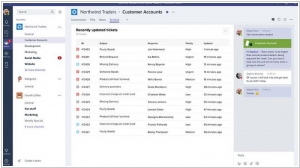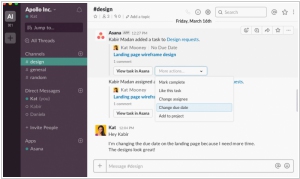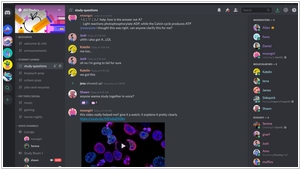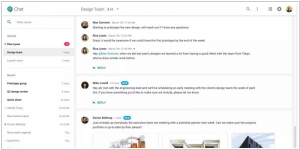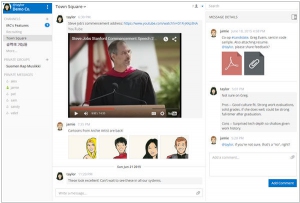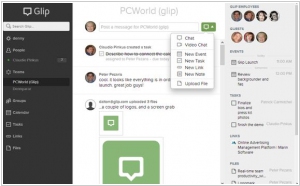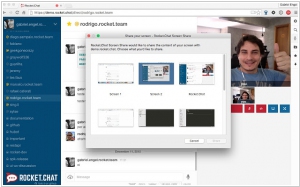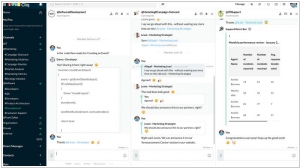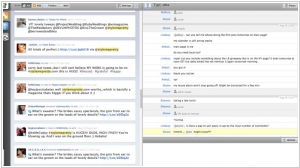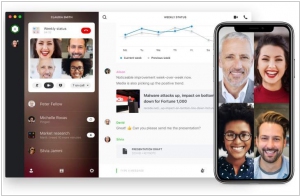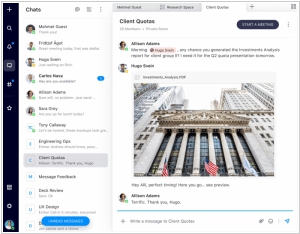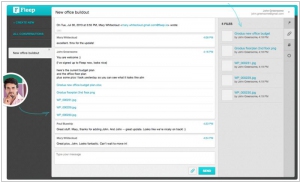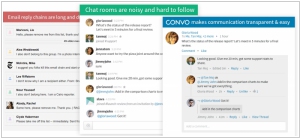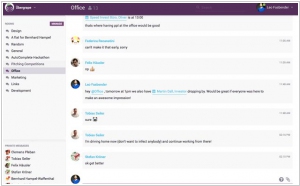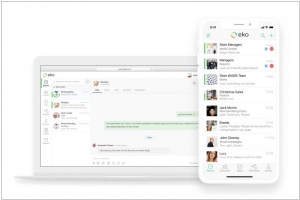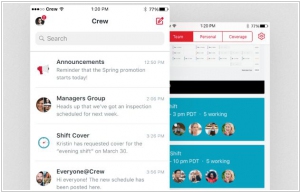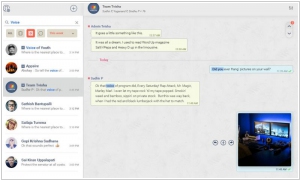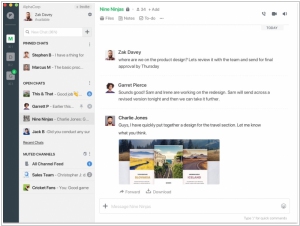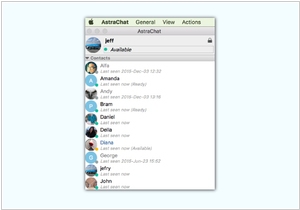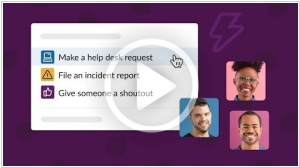Top 10 Team Messaging platforms
February 03, 2024 | Editor: Adam Levine
12
Team messaging platforms are communication tools designed to facilitate real-time collaboration and streamline communication within teams or organizations. These platforms offer features such as instant messaging, file sharing, video conferencing, and project management integration, providing a centralized hub for team members to exchange information, coordinate tasks, and maintain efficient workflows, even when working remotely or across different time zones.
1
Microsoft Teams is the chat-based workspace in Office 365 that integrates all the people, content, and tools your team needs to be more engaged and effective.
2
Slack brings all your communication together in one place. It's real-time messaging, archiving and search for modern teams. Create open channels for the projects, groups and topics that the whole team shares. Slack searches whole conversations, not just individual messages, so you can find what you’re looking for no matter who said what or when they said it.
3
Discord is a VoIP and instant messaging social platform. Users have the ability to communicate with voice calls, video calls, text messaging, media and files in private chats or as part of communities called "servers".
4
Google Chat is a communication service developed for teams and business environments, but also available for general consumers as chat in GMail and mobile app.
5
Open source, on-premises, Slack-alternative. Like Slack, you can send messages and files across channels, get notifications on unreads and mentions, and search history–all from your PC or smartphone.
6
Plan, share, & organize work in real-time. Glip organizes your team’s work while you chat with your co-workers, and makes your conversations productive. All your projects, meetings and files live in the stream, so everyone is in the loop on what’s happening.
8
Zoho Cliq combines content and communications into a single view to give you a comprehensive picture of your team's work. Zoho cliq is designed to let information flow freely to bring about that much required transparency to work.
9
CA Flowdock is a team collaboration app for desktop, mobile & web. Work on things that matter, be transparent and solve problems across tools, teams & time zones. One place to talk and stay up-to-date.
10
Wire is an encrypted communication and collaboration app. The most secure collaboration platform
11
Jumpstart team productivity. Everything you do is protected by Symphony’s unique end-to-end security. Enhance your messages with rich editing, images, tables and files. Hashtags, cashtags and mentions - never miss an important message with personalized filters. Secure access to your conversations on your desktop or on your iPhone.
12
Fleep is chat for teams and businesses. Your files and messages. Always in sync. On all devices. Team communication is now a simple, common-sense thing. Fishing for someone’s wise words in an ocean of chat? Instead, pin important messages to the side so everyone can see and edit them. Task lists, meeting notes, important links, etc. As with messages, trawling for files in a long conversation wastes your life. In Fleep, all photos and documents have a nice clean drawer on the side tab, next to the conversation flow.
13
The private enterprise social network for real-time collaboration. Stay connected to your team and projects via this next-generation social business tool. With Convo Chat on mobile, start your morning catch up while you're on the train, or walking to work and continue the conversation on your desktop at work.
14
Take your conversations with you, wherever you go. Stay connected to your colleagues and don't miss a discussion anymore - the ChatGrape mobile apps for iOS and Android will keep you updated and let you join the conversation easily, no matter where you are. Reference all data from your external services from within ChatGrape right as you type - with an autocomplete that knows your business.
15
Mobile-first internal communication platform for your mobile-first workforce. Bring your team. Increase staff engagement, productivity and efficiency.
16
Crew is a communications app that keeps everyone on the same page for everything work-related.
17
Troop Messenger – a comprehensive instant messaging app for businesses-small to giant. Instant Messaging, Video Call, Video Conferencing, File Sharing, Desktop Sharing, Work Schedules and Projects on Troop Messenger - The Unified Business Communication Platform
18
Flock, the best team communication app and online collaboration platform, comes with team messaging, project management and other great features that improve productivity and boost speed of execution.
19
AstraChat is an open-source alternative to WhatsApp and Slack for large organizations that want their own private messaging servers in the cloud or on premise. AstraChat is a complete XMPP-based messaging solution that is ideal for governments, police, military, banks, insurance, finance, and healthcare companies that value privacy and security.
Latest news about Team Messaging platforms
2023. TeamSense helps manufacturers keep in touch with deskless workers
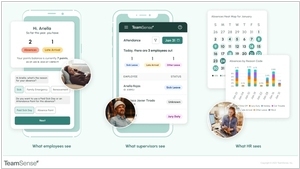
TeamSense, an app-free platform designed specifically for hourly employees in the manufacturing sector which lets them manage attendance, talk to managers and access company resources through SMS, has raised $4. TeamSense’s features include Absence Management, an employee call-out system the company says has a 100% adoption rate. It lets employees call out of work more easily and helps manufacturing companies get accurate employee numbers. The platform also has communication tools, engagement and pulse surveys, an employee portal with access to internal resources and a “text to apply” feature for job applicants.
2023. Microsoft’s AI-powered Designer tool comes to Teams
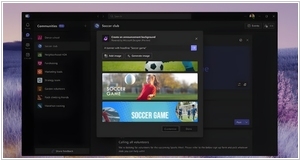
Microsoft is introducing its AI-driven art creation tool, Designer, to the free version of Teams. Users of Microsoft Teams can now utilize Designer, an app similar to Canva, to generate various designs for presentations, posters, digital postcards, and other purposes. These designs can be shared on social media platforms and other channels. Designer can generate designs based on text prompts or uploaded images by leveraging DALL-E 2, OpenAI's text-to-image AI. The tool offers options for customization and personalization through drop-down menus and text boxes. Designer is accessible through the web, Microsoft's Edge browser via the sidebar, and now within the free version of Teams. The announcement of Designer was initially made in October, and new features such as caption generation and animated visuals were added in April. Microsoft has also promised additional advanced editing features in the future.
2023. Microsoft rebuilt Teams from the ground up, promises 2x faster performance
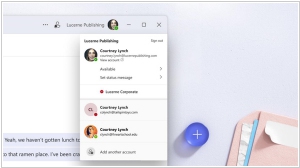
Microsoft Teams, which competes with Slack, has had a reputation for being slow and resource-intensive since its launch, which some attributed to Microsoft's rushed response to Slack's success. However, Microsoft has now launched a preview of a new version of Teams that it describes as a "reimagining of Teams from the ground up." The new application promises to offer twice the performance of the previous version while using only half the memory. This means that joining meetings should be twice as fast, and switching between chats and channels will be 1.7 times faster. The company has also redesigned the user experience of the platform.
2023. Discord updates its bot with ChatGPT-like features
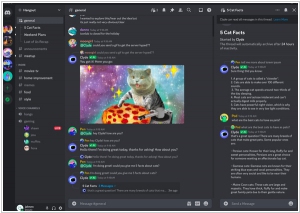
Microsoft has officially announced the general availability of ChatGPT, which can now be accessed through the Azure OpenAI Service. This service, tailored for enterprises, offers a fully managed platform with additional governance and compliance features to ensure businesses can leverage OpenAI's technologies effectively. ChatGPT now joins a lineup of other OpenAI-developed systems already provided via the Azure OpenAI Service, including the text-generating GPT-3.5, code-generating Codex, and image-generating DALL-E 2. Microsoft maintains a strong collaborative partnership with OpenAI, marked by substantial investments and an exclusive agreement to commercialize OpenAI's AI research.
2023. ByteDance’s Slack-like tool generated $100M in 2022
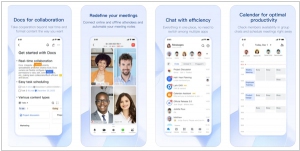
Feishu, the workplace collaboration app developed by ByteDance, achieved an annual recurring revenue of over $100 million in the previous year. Feishu, known internationally as Lark, is a comprehensive work communication messenger that offers convenient features such as automatic notetaking for video calls, shared calendars, and collaborative document editing. Towards the end of 2021, the workplace tool was designated as one of ByteDance's six individual business groups, signifying its strategic significance within the company. The other business groups at ByteDance include TikTok, Douyin, Dali (education), BytePlus (B2B AI and data infrastructure), and Nuverse (video games).
2022. Microsoft Teams targets Facebook Groups with new Communities feature
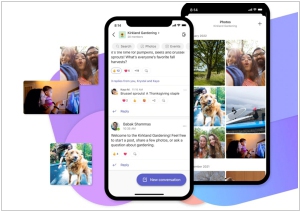
Microsoft Teams has recently introduced an exciting feature called "Communities" for Android and iOS devices. This new feature enables users to create and organize groups within their community, such as sports clubs, event planning committees, parent-teacher associations, and more. With Communities in Microsoft Teams, users gain access to a range of collaborative tools and functionalities, including group calendars, event scheduling, document and photo sharing, video calls, and chat capabilities. Additionally, the feature offers a "new events experience" that allows users to add events to their community calendar, invite guests, track attendance, and engage in private conversations with attendees. Currently, Communities is available in the free version of Microsoft Teams and is initially accessible on mobile devices, with plans for desktop compatibility in the near future. This new addition aims to enhance community collaboration and streamline communication within Microsoft Teams' user-friendly interface.
2022. Slack adds persistent information layer to channels called Canvas
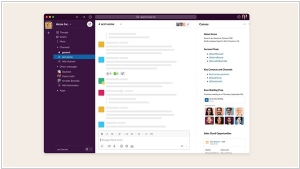
Slack has achieved considerable success in the enterprise realm by offering various communication options and seamless integration with common enterprise applications. However, until now, Slack has lacked a persistent way to share project-related information. While users could create channels to narrow down content and share documents, links, and other materials, finding them again required searching or extensive scrolling. Acknowledging this limitation, Slack has taken a step forward by combining the collaborative tooling of Quip with Slack's communication capabilities, resulting in a new tool called Canvas. Positioned alongside a channel's conversation stream, Canvas grants users access to a range of information, including data and charts, text, tasks, internal and external links, training videos, and more. This integration allows for a seamless experience where project-related information can be easily shared and accessed within the Slack platform.
2022. Slack gains new automation features, including conditional logic for workflows
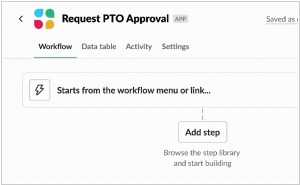
Announcing a significant update, Slack has introduced new automation features aimed at enhancing the shareability and discoverability of workflows. Building upon the existing Workflow Builder tool launched in 2019, these latest capabilities enable users to easily send workflows to other Slack users and utilize "if-then" statements to create more advanced flows. Slack's increased focus on automation aligns with the growing popularity of no-code development tools, which empower users to build apps and pipelines without requiring programming expertise. According to a survey conducted by 451 Research and FileMaker, nearly 60% of all custom apps, including automations, are now developed outside of the IT department. Furthermore, the survey revealed that 30% of these apps are created by employees with limited or no technical development skills. This trend emphasizes the importance of providing accessible automation solutions to a broader range of users.
2022. Slack is increasing prices and changing the way its free plan works
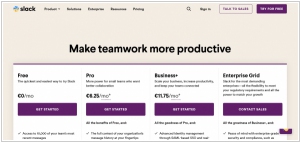
Slack, the chat platform widely used as an online watercooler for numerous teams, is implementing changes to its pricing structure and free plan functionality. For users subscribed to the "Pro" plan on a monthly basis, the price will increase from $8 per user per month to $8.75 per user per month. Similarly, for users on the annual "Pro" plan, the price will rise from $6.67 per user per month to $7.25 per user per month. As for the free plan, Slack is modifying how messages are stored. Previously, free users had access to the last 10,000 messages and 5 GB of uploads. Going forward, message retention will be based on time rather than quantity, allowing free users to view the last 90 days' worth of messages and uploads, regardless of the volume exchanged.
2022. Flip, a chat and HR app for frontline workers, raises $30M
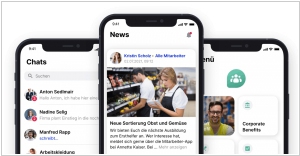
Flip, a company that has developed a communications app specifically designed for frontline workers, has successfully raised $30 million in funding. The app serves as a platform for frontline employees to engage in conversations with their colleagues, receive communication from management, and carry out various HR activities such as shift swapping. In a market that targets the same segment of the global workforce and addresses the same communication needs, Flip competes with other notable apps such as Workplace from Meta, Microsoft Teams, Crew (now owned by Square), Blink, Yoobic, When I Work, Workstream, and many others. It is worth mentioning that today, Snapshift, another app focusing primarily on HR aspects within the realm of frontline work, also announced its own funding news, highlighting the growing opportunities in this sector.
2021. Twitter acquires messaging platform Quill
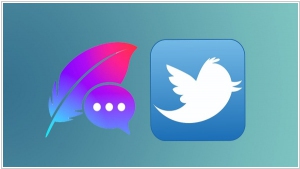
Twitter has recently acquired the messaging app Quill, which bears similarities to Slack, in order to enhance its messaging services, including direct messages. As a result of the acquisition, Quill will be discontinued, but its team will be integrated into Twitter's Experience organization. Consequently, Quill will deactivate its servers and delete all associated data. Customers who are currently active on the platform will receive full refunds. Quill was initially designed for work-related conversations, offering controls to mitigate some of the distracting elements found in Slack. Its structured channels facilitated more focused discussions compared to the conventional chat thread organized in reverse chronological order, and message threads could be separated and relocated to distinct conversations.
2021. Blink, a productivity app aimed at frontline workers, raises $20M
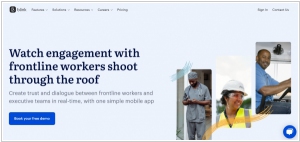
The market for apps targeting frontline workers is experiencing a notable surge as businesses increasingly recognize the value of leveraging technology to enhance communication with these employees. This trend has attracted the attention of investors, who see a promising growth opportunity in enterprise IT. In line with this trend, Blink, a startup offering an app with the same name, has recently secured $20 million in Series A funding. Blink's platform enables frontline workers to access and engage with various IT services utilized by their organizations, as well as connect with their colleagues. One of Blink's distinguishing features is its user interface and functionality, designed to cater to both asynchronous activities and real-time information. Recognizing that frontline workers may not be continuously engaged with the app throughout the day, Blink prioritizes surfacing important information when they do interact with it. This approach ensures that critical updates and notifications are given the necessary visibility and prominence.
2021. Microsoft Teams gets 3D animated avatars

Microsoft has unveiled 3D avatars for Teams meetings, offering an alternative for those who prefer not to appear on camera. These animated and personalized avatars are part of the "Mesh for Teams" initiative, which combines Microsoft's Mesh platform for shared experiences in virtual reality, augmented reality, and other realms with Teams and its integrated productivity tools. This feature transforms traditional meetings into a unique experience. Users can access Mesh for Teams using various devices, ranging from smartphones to VR headsets or HoloLens. Microsoft also allows businesses to create their own spaces, or metaverses, within Teams, enabling individuals to virtually interact and collaborate.
2021. Google Workspace opens up spaces for all users
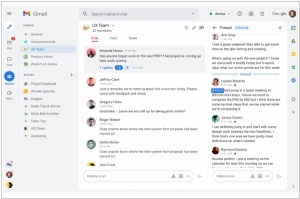
Google has introduced spaces within Google Chat, making them available to all users. These spaces seamlessly integrate with various tools in Google Workspace such as the calendar, Drive, and documents. This integration offers a hybrid work experience, enabling users to access the complete history, content, and context of conversations regardless of their location. Instead of resorting to lengthy email chains or scheduling video meetings, teams can collaborate directly within a space to drive projects and discussions forward. The updated features in spaces include a unified interface that combines inbox, chats, spaces, and meetings. Spaces and their content can be made discoverable, allowing individuals to find and join conversations. Additionally, improved search capabilities within a team's knowledge base, the ability to reply to any message within a space, and enhanced security and admin tools for communication monitoring are also part of the new update.
2021. Yoobic raises $50M for its chat and communications app aimed at frontline and service workers
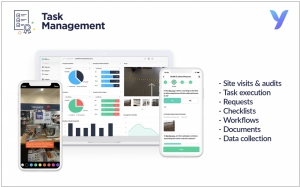
Slack has undeniably set the bar for workplace collaboration apps in catering to the needs and expectations of knowledge workers. However, there has been a notable gap in addressing the requirements of frontline workers. To fill this void, Yoobic has emerged as a solution, providing an app designed specifically for frontline and service workers. The Yoobic app enables these workers to efficiently manage tasks, communicate with their peers and management, and access training, development, and e-learning resources. Recently, Yoobic secured $50 million in funding. The company collaborates with approximately 300 renowned brands across 80 countries, encompassing an extensive network of 335,000 locations within sectors such as retail, hospitality, distribution, and manufacturing.
2021. Messaging app Wire raises $21M
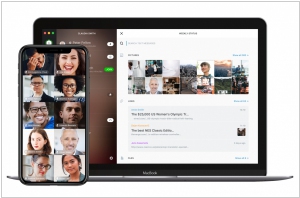
Wire, a messaging app and service that prioritizes end-to-end encryption, has successfully raised $21 million. Although Wire initially targeted a consumer audience, it did not achieve the same level of widespread adoption as other messaging apps. As a result, the company has shifted its focus to larger customers, including major corporations and government entities with a significant number of potential users. Currently, Wire is being utilized by five G7 governments and has amassed 1,800 customers in total. In addition to enhancing its Messaging Layer Security (MLS), Wire has dedicated efforts to improving conference calls and real-time interactions. Recognizing the gradual convergence of messaging and real-time collaboration apps, the startup aims to provide a versatile service that performs well across various scenarios.
2021. Microsoft updates Teams with new presentation features
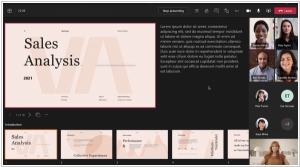
The Microsoft Teams platform is introducing a new feature called PowerPoint Live, which enables presenters to deliver presentations while having access to their notes, slides, and meeting chats all in one comprehensive view. This feature enhances the presenter's experience by providing convenient access to essential resources during the presentation. Additionally, PowerPoint Live benefits attendees by allowing them to navigate through the presentation at their own pace or utilize screen readers to improve accessibility. This exciting feature is now accessible within Teams, offering users a more streamlined and interactive presentation experience.
2021. Rocket.Chat raises $19M for its open-source approach to integrated enterprise messaging
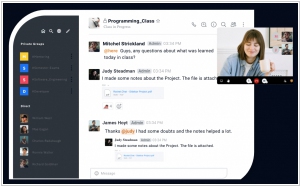
Rocket.Chat, an open-source alternative to Slack, has recently secured $19 million in funding. Rocket.Chat positions itself as a comprehensive communication solution, allowing organizations to customize and integrate various services based on their unique requirements. Users have the option to self-host and manage the platform or opt for a cloud-based Software-as-a-Service (SaaS) model. Pricing varies, starting from free for minimal self-hosted services and going up to $4 per user per month. While Rocket.Chat's foundational platform resembles Slack, it offers additional capabilities for omnichannel customer service communications. Users can create a tailored platform within Rocket.Chat, incorporating communication channels from other platforms used to interact with customers. This flexibility makes Rocket.Chat a versatile and customizable communication hub for organizations.
2020. Salesforce buys Slack for $27.7B
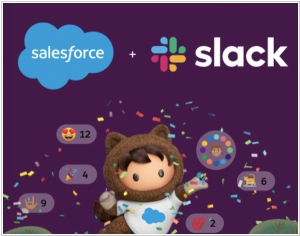
Salesforce, the renowned CRM giant, has embarked on a monumental $27.7 billion acquisition of Slack. This substantial deal positions Salesforce in closer competition with its longtime rival and occasional ally, Microsoft, whose Teams product has been directly challenging Slack in the market. Microsoft, having previously passed on acquiring Slack for a fraction of the current purchase price, has now prioritized Teams as a key focus, determined not to concede any portion of the enterprise software market to another company. What has truly set Slack apart, particularly in its early stages, is its remarkable ability to seamlessly integrate with other enterprise software. Coupled with intelligent digital assistants known as bots, Slack has the potential to offer Salesforce customers a centralized platform where they can carry out their work without shifting focus, as virtually all their necessary tasks can be accomplished within the Slack environment.
2020. JANDI (the Slack of Asia) raises $13M
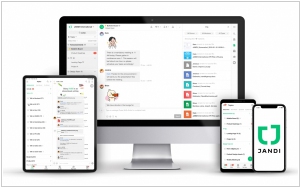
As Slack strengthens its presence in Asia, Toss Lab, a South Korea-based company and the creator of the enterprise collaboration platform JANDI, is positioning itself as a formidable competitor by raising $13 million in a Series B funding round. JANDI has established itself as the leading collaboration platform in Japan and Taiwan. Its user base spans across small to mid-sized businesses as well as large enterprises with thousands of employees. Notable clients of JANDI include LG CNS (the IT services subsidiary of a Korean conglomerate), Nexen Tire (a Korean tire manufacturer), and Lexus. Toss Lab reports impressive revenue growth of over 100% in the past three years.
2020. Microsoft updates Teams with new automation and scheduling tools
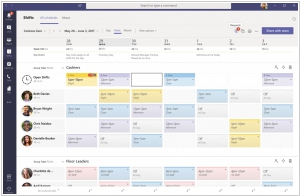
Microsoft has introduced a range of updates for its collaboration and communication platform, Teams. These updates primarily focus on enhancing the meeting experience within Teams. Users can look forward to scheduling, managing, and conducting virtual appointments using the Bookings app. Additionally, Teams' Shifts app will receive new capabilities, including triggers and templates that enable automatic approvals for shift requests, eliminating the need for manager approval in certain cases. Microsoft is also planning to streamline the integration of Power Apps and Power Automate business process templates into Teams, making it more convenient for users. Furthermore, Power BI users will soon have the ability to effortlessly share reports with Teams by simply clicking a single button.
2020. Leverice - team messenger that’s taking aim at information overload
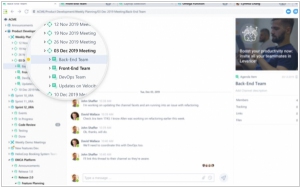
Leverice is a recently launched team messenger and collaboration platform that aims to compete with industry leaders such as Slack. It addresses the persistent issue of overwhelming information overload in real-time messaging. These tools can often hinder productivity rather than enhance it, leaving users stressed and unsure about managing the constant stream of work-related communications. Leverice differentiates itself by providing a superior triage structure, ensuring important information doesn't get lost amidst the unstructured conversations typically found in other chat platforms.
2020. Slack introduces simplified interface as usage moves deeper into companies
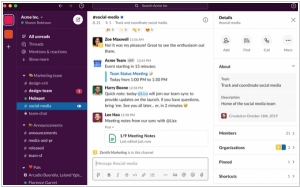
Slack has unveiled its most significant update to date, focusing on enhancing the user experience and transforming it into a more accessible enterprise communications hub. Over the years, Slack has continuously introduced new features to meet the evolving needs of its user base. However, this has led to some interface clutter. The latest redesign aims to address this issue. In addition to a cleaner overall look, one notable feature is the ability to nest channels in the Channel sidebar, allowing for better organization. As the number of channels grows, it can become challenging to navigate through them all. With the new update, users now have the option to group their channels logically and label them for easier access and management.
2020. Microsoft updates Teams communications platform with targeted messaging
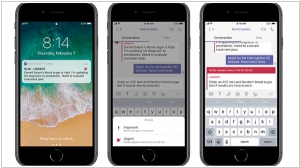
Microsoft has unveiled several enhancements for its Microsoft 365 platform, aimed at enhancing communication within care teams and facilitating seamless telehealth visits with patients. Notably, targeted communication has been introduced in both the mobile and desktop versions of Microsoft Teams, benefiting healthcare providers. By assigning specific tags to individual staff members based on roles, departments, or other relevant groupings, targeted messages can be delivered within the chat platform to specific groups of employees. These updates aim to streamline communication and improve collaboration within healthcare settings.
2020. Flip raises $4M to pounce on the growing sector of employee messaging – TechCrunch
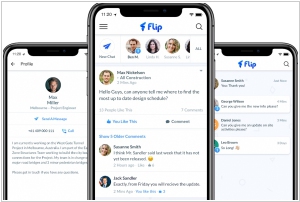
Flip, an employee messenger app headquartered in Germany, has recently raised $4 million in funding. The startup provides a platform that enables companies to connect and communicate with employees at all levels while adhering to legal compliance requirements. The application is built upon a data and employee protection concept that complies with the General Data Protection Regulation (GDPR), and its validity has been verified in collaboration with experts and works councils from several prominent DAX companies. Furthermore, Flip seamlessly integrates with various existing corporate IT infrastructures. The startup has already garnered an impressive customer base, including renowned companies such as Porsche, Bauhaus, Edeka, Junge IG Metall, and Wüstenrot & Württembergische. Additionally, portions of Sparkasse and Volksbank, as well as Deutsche Telekom, have also embraced Flip as their partner.
2020. Microsoft Teams is getting push-to-talk feature
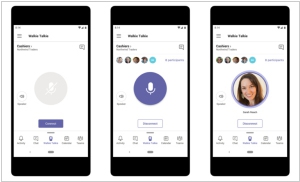
Microsoft is introducing a new feature called Walkie Talkie to its competitor to Slack, Microsoft Teams. This feature, which will be available in preview within the next few months, enables smartphones or tablets to function as walkie-talkies, utilizing either Wi-Fi or cellular data. It primarily targets "firstline workers" who directly engage with customers and handle day-to-day operations within organizations. Microsoft positions this feature as a more secure alternative to traditional walkie-talkies. By placing the feature in the center of the navigation bar within Microsoft Teams, Microsoft indicates that it is a highly anticipated and widely applicable functionality that will be adopted by numerous companies.
2019. Messaging app Wire raises $8.2M
Wire, an enterprise-oriented messaging service offering end-to-end encryption, has recently secured a discreet funding round of $8.2 million. Additionally, the company has relocated its holding company from Luxembourg to the United States. Wire intends to introduce a freemium tier to its existing consumer service, which currently boasts half a million users. Alongside this expansion, the company is actively seeking a larger round of funding to drive further growth in its enterprise business, which played a significant role in the decision to move to the US. Presently, Wire maintains its operations without significant changes. Customer licensing and service remain in Wire Switzerland, software development is carried out in Berlin, Germany, and hosting continues to be based in Europe.
2019. Slack investor Index Ventures backs Slack competitor Quill
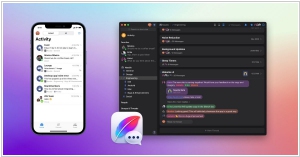
Quill, a promising competitor to Slack, has recently secured a seed round of $2 million. The company aims to provide users with meaningful conversations that do not disrupt their team's workflow. Quill has developed a streamlined messaging product, currently in beta, which prioritizes focused discussions through the use of threaded conversations. Notably, Index Ventures, the investment firm, is showing strong support for the growing market of workplace communication software. In 2015, the firm initially invested in Slack, which successfully completed its highly anticipated direct listing earlier this year. Slack went on to raise hundreds of millions more in funding, ultimately reaching a valuation exceeding $7 billion in 2018.
2019. Slack adds workflow automation feature
Slack has introduced Workflow Builder, a visual tool that empowers all Slack users to automate repetitive tasks by creating personalized workflows. With just a few minutes of setup, you can establish streamlined processes for gathering team requests, promptly reporting any service disruptions, welcoming new team members with automated messages, and a multitude of other valuable applications. To kickstart your workflow-building journey, it's recommended to leverage one of Slack's pre-built workflow templates, which can be easily downloaded and imported. These templates include features such as automatically onboarding new teammates with welcome messages, using custom forms to request specific information, and swiftly collecting real-time incident reports.
2019. Facebook Workplace dives into enterprise video content management
To leverage the increasing emphasis on video within Facebook's consumer service, Facebook Workplace has taken several initiatives to enhance its own video capabilities. One notable step is the introduction of a dedicated app for the Portal, Facebook's video screen. Additionally, Workplace is introducing new video features, including captions displayed at the bottom of videos, automatic translation for 14 languages, and a new peer-to-peer (P2P) architecture that optimizes video transmission in bandwidth-constrained environments. These enhancements aim to differentiate the Workplace experience and demonstrate its suitability for businesses. While companies may already be using platforms like Slack, Workplace offers a compelling alternative or complement, encouraging businesses to consider adopting or migrating to this platform.

